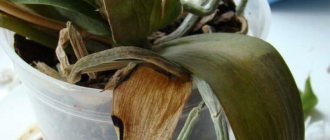If the plant freezes during transportation in cold weather, then you need to know how to properly resuscitate it so as not to destroy the plant.
When the leaf blades of a plant become frostbitten, they become covered with wet spots, and if most of the leaf blade is affected, it dies, gradually turning yellow .
These spots are slimy to the touch and resemble jelly. At the same time, they can increase in size. If such jelly-like spots are detected, it is necessary to urgently begin resuscitation of the plant.
If you have frozen an orchid, you must urgently begin resuscitation.
Frostbite spots can appear not only during transportation in the cold season, but also when keeping a tropical beauty in cold home conditions . After all, a temperature of +16 is destructive for this exotic flower. A frozen orchid needs urgent resuscitation and can be restored.
If weeping spots are detected on the leaf blades, it is necessary to begin treating the flower so that it does not die completely. So, what to do if the orchid is frozen? How to save a frozen plant?
IMPORTANT! You can save a flower if there are very few spots. But if it has completely turned into mucus, then the flower cannot be revived.
Frostbite on leaves: what to do if the orchid is frozen?
With the onset of frost, questions regarding saving a frostbitten Phalaenopsis orchid have become more frequent.
And this despite constant warnings about the need for insulation. So, let’s figure out what plant frostbite is and how you can help the beauty in such a difficult situation. What frostbitten orchid leaves look like
The appearance of frostbite on orchid leaves looks like this: wet spots that feel slimy to the touch. Often accompanied by the release of fluid. Over time, frostbitten leaves turn yellow and die.
Plants can freeze not only when transported from the store to home, but also at home if kept cold. So, for example, it is enough to hold a hybrid Phalaenopsis orchid in a warm temperature regime for half an hour at a temperature below +16 degrees, and frostbite is “ready”. For orchids in cold temperatures, temperatures of +2 - -1 degrees are detrimental.
In winter, orchids often get frostbite when ventilating rooms if a stream of icy air passes through them. Also, during the cold season, orchids freeze their leaves when they come into contact with glass.
What to do if your orchid is frozen?
If the entire plant has become slimy, wet and soft, it cannot be treated.
If the spots appear on several sheets, then carefully cut them out with a sharp, clean blade to healthy tissue, sprinkle the cut with crushed activated carbon (iodine and brilliant green can be used to treat the wound only if there is a fairly large distance left to the neck/stem).
If frostbitten spots are located close to the orchid stem, remove the leaf completely. To do this, we make a cut along the leaf, pull the two halves in different directions and remove them from the stem along with the covering scales. All actions must be careful. To disinfect the wound on the orchid stem, sprinkle only with crushed activated carbon.
Next, we care for the plant as usual. The first watering can be done with Zircon, and 2 weeks after treatment, spray the leaves with Epin. The benefits of Zircon and Epin are written HERE.
Hello! I share my interesting experience of obtaining a rich harvest. I came across an interview with Mikhail Chursin, Doctor of Agricultural Sciences, and inspired by the article, I decided to take his recommendations, and you know, I was right... All summer we ate cucumbers and tomatoes from the garden, and also prepared some for ourselves and our family for the winter. For those interested, here is a link to the article.
orch >All the most interesting things about Orchids!
With the onset of the cold season, more and more flower growers are beginning to wonder what to do if the orchid is frozen, how to correct the situation. Despite regular warnings that the plant does not tolerate cold and drafts, it often happens that the leaves of indoor plants get frostbite. Initially, you need to learn to determine when a flower is frozen.
There are several undeniable signs that a flower urgently needs help. The first warning sign is wet spots on the leaves that feel slimy to the touch. Leaves that have received frostbite will eventually turn yellow and die. Therefore, when an orchid is frozen, it is necessary to act urgently.
The plant can become hypothermic not only during its trip home, but also if it is kept excessively cold. For example, for Phalaenopsis orchids to get frostbite, it is enough to stay at a temperature of 16 for about half an hour. That is, any temperature that deviates from the norm downward by two to three degrees is destructive for a flower.
What to do?
Before saving an orchid that has frozen, you need to make sure that it can “survive” it. A plant that is completely covered with mucus and becomes soft cannot be restored. You can safely throw it away. You can revive a flower when there are wet spots on several of its leaves.
Before the procedure, it is necessary to prepare a sharp new blade, which is pre-treated with an alcohol solution. Stains should be carefully trimmed straight to healthy tissue. The cut sites are treated using crushed activated carbon; brilliant green or iodine can be used for disinfection only if the cut was made far from the stem.
There is also a separate method for reviving a frozen orchid if the leaves are damaged close to the stem. To do this, you need to make an incision along the diseased leaf and carefully remove it from the pseudobulb, pulling the ends in different directions. Wounds received after the removal procedure must be generously sprinkled with crushed cinnamon or activated carbon.
Aftercare is carried out as usual. The first watering is best done using Zircon, which is added to soft water. Two weeks after the day of resuscitation, the above-ground part of the flower should be sprayed with Epin solution. These substances will help the plant recover faster after serious treatment.
So we see that restoration is possible, however, according to experts, the plant spends a lot of energy in the process of saving, so we can’t expect flowering for the next two years. In addition, if the orchid froze once, repeated incidents should not be allowed, because repeated resuscitation may have an effect. To prevent hypothermia, it is best to move the pot deep into the room for the winter.
Reviews and comments
It is very heavy to search a service which offers receiving prompt loans online. Many of our mates or economic companies don't provide long-term loans in the USA without any data. As rule, you may search any companies which grant coins without different certificates. It is possible to search service installation loans online in KY here.
At maybeloan.com you could take loans without comrade support or other banks. It is feasible to take loans in the varied town in the USA for a few clicks. The main task of this service is to solve client problems with cash. It suggests some of the clients receive coins fast without high-interest rates. That is why this project connects with different credit models in finance and financial market which simplified the operation of receiving a loan. This maintenance also aids to do installation loans in different areas. For example, if you require financial services, you can to apply for installation loans in Alabama virtually.
Different persons in Alabama have their own issues with credits and banks. That is why the service provides an opportunity to take on online installation loans with no credit check in Alabama. It is the new opportunity which supports people to be irrespective of banks. At service Maybeloan is working team of specialists. In the view of the team, the major task is to grant men cash fast and solve their economy issues. Currently easy installation loans in Alabama help to solve problems with various purchases in shops.
If to say about superior installation loans in Alabama, we commend using maybeloan.com where you can take credit online for 10 minutes. A lot of men prefer to use financial online services without credit check and you can however use AL virtual installation loans with no banking check. Most men all over the regions haven't chances to visit a banking house. That is why the best method to employ credits is online way. As rule, if you desire to employ cash at Alaska but Alaska's banking houses don't grant for your coins, you could take credits at online services which grant credits folk with awful credit installation loans in Alaska.
If you have poor credit data at Connecticut, it is not a problem, because of installation loans for bad credit in Connecticut you can take on money as fast as it possible at virtual service like Maybeloan. With this service, each can take on cash online. You can get coins virtual with iPhone or PC. However, now this service is a business model, which grant credits to people in different cities in the USA online. If your microeconomic organization needs money in Delaware, don't worry. Some long-term installation loans in Delaware allow people with various data. You could take on money online even awful credit installation loans in DE with support of service Maybeloan.
Service furnishing services of installation loans in Indiana. You could apply online 24/7 and be happy. You could choose these company because they don't load different payment. The application form is very readily available and you could take a loan not more than 10 minutes. Managers who are working at organization don't verify your debit history. That is why at the organization are working some versions which grant best services.
This company issued mortgages more than $20,000. Today there are more than 2500 complacent customers all over the world who use this service. It is really very light to utilize coins online with the aid of these services. You must apply the application blank. It is online. Processing is not more than 10 minutes. Most of the clients obtained approved. The client will receive coins. Different visitors who utilize cash – take it for business targets online. A lot of firms who work like business companies using cash there. You should be sure that money from their account will be the transfer for your data successfully.
Causes of freezing
Frostbitten fragments have a jelly-like appearance. Over time, the lesions may increase in diameter.
Stains appear not only due to improper transportation during the cold season, but also due to violations of maintenance conditions.
There are several situations when a home orchid can freeze. Let's look at each of them.
- Location on a window in winter or frequent ventilation. Frozen flower crops are not sprayed until they are completely restored.
- Placing an orchid under an air conditioner causes it to become hypothermic.
- Even if the air is too dry, there is no need to carry out foliar spraying. To increase the required humidity, you should place a container of water next to the flower or use home air humidifiers.
- A sharp drop in temperature. For most orchids, just half an hour in a room at low temperatures is enough for the above-ground part to freeze. If exposed to such unfavorable conditions for a longer period of time, the root system will also freeze.
The minimum room temperature is 15°C. A drop below this level is detrimental.
Resuscitation of individual parts of the plant
To revive a frozen orchid, you need to focus on the condition of the damaged vegetative parts.
At the same time, it is possible to revive the flower if the area of frostbite is small.
If the plant is completely frozen and the entire above-ground mass has become slimy, in most cases it will not be possible to save it.
Root system
Frostbitten roots turn black and die. This causes a malnutrition of the entire plant; without the supply of nutrients, it dies.
In this case, blackness from the root system will quickly spread to the stem, which accelerates the death of the flower crop.
It is possible to save a frozen orchid if no more than 1/3 of its root area is damaged.
- frostbitten fragments are cut to healthy tissue;
- the sections are treated with charcoal or activated carbon and left to dry completely under natural conditions;
- the flower is planted in a fresh substrate and, as recovery is observed, they return to normal care.
Flowering can occur only after 2 years. If a peduncle appears ahead of time, it is recommended to cut it off, because it will take away most of the nutrition, and the growth of the required number of roots will stop.
When resuscitating the root system, greenhouse conditions are not created for a frozen plant, as high humidity provokes rotting.
Foliage
Frostbitten green mass is not restored. At first it becomes wet and slimy to the touch, liquid is released from the spots, and then it turns yellow and falls off.
Leaves with frostbitten lesions must be removed, especially if they are located near a healthy trunk, so that the rot does not spread over the entire vegetative surface.
The exception is small wounds, which can be trimmed and sprinkled with charcoal or activated charcoal for disinfection.
- cuts are made at the ends of the damaged leaf plates;
- the cut is stretched in opposite directions;
- the frozen leaf is removed from the trunk;
- the place of contact with the stem is sprinkled with charcoal or activated carbon for disinfection purposes.
This removal helps to get rid of damaged parts without residues that, when exposed to moisture, can trigger the process of rotting.
When resuscitating flower culture, avoid:
- application of contrasting temperature changes;
- using warm showers and watering;
- Place in direct sunlight for warming purposes.
A flower crop saved after frost restores its ability to flower after 1.5-2 years.
Peduncle
The frozen peduncle is cut with a sharp tool to the first bud that has survived frost damage.
When the flower crop grows new foliage, the dormant growth point is activated with the help of a hormonal paste to stimulate the growth of the peduncle and the beginning of flowering.
Top
If the leaf mass and peduncles turn into mucus after frostbite, then when the apical part freezes, the flower can be revived faster.
The top is cut off, which will stimulate the active development of side shoots.
Rules for transportation in cold weather
The basic rule when buying an orchid in winter: the plant is carefully packaged, providing reliable protection not only for the above-ground vegetative mass, but also for the roots.
When transporting over long distances, it is better to use a car.
- at temperatures from 0°C to -10°C, it is enough to wrap an indoor flower in two layers of thick paper, place it in a plastic bag and block the access of air with tape or a stapler;
- when the frost is below -10°C, put padding polyester, burlap or foam rubber into the packaging;
- at -25°C, it is better to postpone the purchase until another day, but if this is necessary, then initially the flower pot is protected from air-tight polyethylene, then wrapped twice in a paper layer and covered with warm material on top.
When delivered to a warm room, the flower crop is not immediately unpacked, but is given time (about 0.5 hours) to adapt due to the sudden change in temperature.
Otherwise, due to critical changes, the orchid will receive shock, which manifests itself in the form of:
- dehydration;
- burn spots on foliage;
- drying out;
- accumulation of ammonia compounds in leaves followed by their death;
- destruction of chlorophyll in plant cells, loss of color and yellowing of the vegetative mass.
How to save an orchid if it is frozen?
An orchid is a plant that belongs to the monocotyledons; its structure is very delicate and requires careful care. This flower is a wonderful interior decoration and is suitable for amazing installations. The bushes are very diverse in nature, but they all look great thanks to their different types and flowering characteristics.
Nevertheless, the orchid is quite demanding to care for, and if care is not taken correctly, the flower may wither. One of the most common causes of plant death is freezing.
If saved after freezing, the plant will develop inflorescences only after 1.5-2 years, not earlier.
How to get rid of mold
A common situation is when the roots are not damaged, but there is already mold in the pot. This is perhaps the only case when you can try to do without a transplant, neutralizing the overflow. And then, only if it was already produced not so long ago, and the substrate is in good condition.
The way out of this situation is to water it with a fungicide solution, which we wrote about above. Mold is also a fungus, and this measure will get rid of it.
But after this you need to very carefully monitor the condition of the roots. Since the process of rotting could have already begun, but it was simply not yet noticeable visually. At the first signs of rotting, you need to immediately proceed to replanting.
To summarize, we will say that the roots of the orchid, as an epiphytic plant, are unusual. They require light and air. They not only nourish the plant, but also take part in photosynthesis. Their surface contains many hollow cells, which in structure resemble a sponge, and by the same principle absorb moisture from the air. And it is their clogging that leads to the death of the plant. Stagnant moisture does not allow them to breathe, which leads to rotting.
We invite you to watch a video about saving an orchid:
Conditions for favorable growth
When growing an orchid, it is imperative to provide it with the correct growing conditions. Let's take a closer look at what needs to be done.
- The flower does not like homogeneous soil.
- The place where the plant “resides” should be well lit, but without bright sunlight. Illumination must be maintained for 12 hours.
- The temperature depends on the type of plant, and should be between 20 and 30 degrees.
- Air humidity should be more than 50%; artificial humidifiers can be used. You cannot spray the plant, as water wounds will appear on the leaves. It is advisable to water it using a tray in the morning to prevent overflow and rotting of the root system. The water should not be very hard and should sit for a couple of days.
- It is necessary to constantly fertilize the orchid with minerals, which contain phosphorus and iron.
How to prevent withering?
Only proper care can prevent an orchid from wilting.:
- The duration of daylight for phalaenopsis should be at least 10-12 hours. If necessary, the lack of natural lighting can be compensated for by artificial lighting.
- Temperature changes of more than 5 degrees are unacceptable, and it should not fall below +15 or rise above +30.
- The preferred air humidity for orchids is 60-80%. With the exception of the flowering period, phalaenopsis can be sprayed up to 5 times a day.
- Timely watering. On average, orchids need to be watered by immersion once a week, and it is imperative to ensure that the substrate dries out.
- During the flowering period, the orchid needs to be fertilized 2 times a month, the rest of the time as needed.
In addition to wilting, other leaf diseases may occur in phalaenopsis: spots and sticky coating appear. Read on our website what to do to save a flower.
Following these simple rules will prevent the orchid from withering and will give it the opportunity to adapt to our climate, which is so different from its native one. Attentive attention to tropical beauties will allow you to promptly notice the first signs of illness and take the necessary measures before the process becomes necessary.
Frostbite and Precautions
An orchid is a very graceful but fragile plant. The plant senses a slight change in climate very subtly, and reacts instantly if the regime deviates from the usual norms. Frostbite of a flower is damage to the structure of the stem, leaves and root system caused by hypothermia.
To prevent unpleasant consequences from the effects of cold on an orchid, you need to exclude possible options. There are basic precautions that need to be taken in everyday life.
Contents near window openings:
- In winter, it is worth removing the flowers at a distance from the window so that they do not get too cold;
- plants should be avoided or completely moved from frequently ventilated areas;
- Heaters dry out the air very much, but it is worth remembering that orchids begin to freeze at temperatures below 16 degrees.
When moving and transporting, you should also follow a number of important rules.
- It is worth covering the plant on all sides to prevent cold air from entering.
- You should not tighten the fabric too tightly, because the lack of oxygen increases the possibility of attracting negative influences from the outside.
- You cannot leave an orchid open outside at a temperature of 0 degrees, it will freeze.
- You should not shake the plant; it is better to secure it tightly in the car or hold it in your hands during transportation.
- It is advisable to cover the plant with thick paper and cover the top with cellophane - this option is suitable at a temperature of 0 degrees. Packing fabric made of burlap and foam rubber is appropriate for protection at temperatures below 10 degrees. If the temperature drops below 25 degrees, you should avoid traveling until warmer days.
- After you have brought the plant into the warmth, you need to wait for the flower to accept the new conditions and feel comfortable.
Prevention of thermal effects of external factors:
- sudden exposure to different temperatures greatly affects the orchid, and can lead to serious problems: dryness, burn spots, yellowing of foliage;
- It is worth excluding spraying and water treatments during cold periods;
- Another enemy when growing plants is the air conditioner, which either cools or dries out the room, which adds additional hassle.
During the dormant period, it is worth moistening the soil lightly and only the upper part.
Why does this happen to the flower?
Before you take measures to save a withering plant, you must understand the reason, otherwise any restorative measures may cause even more harm. In most cases, loss of elasticity and yellowing of leaves is observed as a result of the following reasons :
- excessive watering or stagnation of moisture in the substrate;
- insufficient watering and air humidity;
- excess or improper use of fertilizing;
- hypothermia or frostbite;
- overheat;
- compaction, rotting or other changes in the substrate;
- root damage;
- parasites, mold (you can learn more about what diseases and pests can destroy phalaenopsis and how to save the plant in this article).
If, in the midst of flowering, an orchid’s flowers begin to fade and fall off, this is also a reason to analyze the possible causes of what is happening and try to take countermeasures as soon as possible.
The reasons in this case may be:
natural process of plant aging;- strong drafts, proximity to an air conditioner, heater, open window;
- stress from changes in external conditions;
- excessive spraying or, conversely, insufficient air humidity;
- lack of lighting;
- excessive or insufficient watering;
- parasite infection.
There is no universal way to revive the withered leaves and flowers of an orchid . If the cause of the disease is incorrectly determined, further actions may further weaken the damaged plant and lead to its death.
We invite you to watch an informative video about the reasons for orchid wilting:
How to save an orchid?
If you find that an orchid has frozen at low temperatures, you urgently need to resuscitate the frozen flower. Carefully examine the plant and evaluate the consequences of freezing, whether it can be saved and revived after frostbite. If you notice affected areas in the form of wet wounds on the outside of the leaves, you should react quickly so as not to lose the entire plant. When restoring, you do not need to be too zealous so as not to harm the plant.
When resuscitating flowers, do not allow:
- no mechanical influences;
- using contrasting temperatures for recovery;
- warm baths and watering;
- exposure of leaves to bright sunlight.
If the leaves have frozen and suppuration has formed, you should try to get rid of the affected areas and sprinkle the joints with ash. Without this, the foliage will turn yellow and completely fall off. But it is worth considering that if the plant was left unattended for a long time after hypothermia and received significant frostbite, then the stem itself may subsequently become infected.
If the fruit is frozen, it must be removed immediately. Usually damage is cut only in the upper part and up to the first leaves and buds. In the early stages of frostbite, you can quickly restore the orchid, and even achieve flowering in the future. If the flower is severely damaged and has turned into a shapeless piece, then treatment at this stage will not give positive results. The reason for this phenomenon was prolonged exposure to low air temperatures. When you notice that the roots have frozen, then most likely the plant has already died. But there are cases in which there is a chance to save the orchid. If you are sure of the viability of your flower, then it is worth examining the root system and removing the affected areas. After this procedure, you need to treat the exposed part of the plant with ash and dry it a little before rooting. Now, having examined the root again, make sure that the disease does not affect healthy areas, and feel free to start planting the orchid.
To learn how to save an orchid if it is frozen, see the following video.
Why did the orchid lose its leaves?
It often happens that an orchid loses its leaves over time. This can happen as a result of a natural process that is common to all plants. In this case, the leaf immediately turns yellow and then dries out completely.
Two leaves may die at the same time, however, there is no need to worry. After all, the bulk of the leaves should remain in their place. In addition, there are orchids that have an incomplete life cycle. These plants may completely lose their leaves in winter, but the root system will remain healthy. Orchid leaves can live up to three years, and in some species - up to seven.
However, it also happens that leaves die as a result of improper care. In this case, you should immediately start to worry, because the entire plant may completely die.
This happens in some cases, let's look at them in more detail.
- Fungal diseases. If the plant is attacked by a fungus, the roots of the orchid are first affected, and only after that the disease spreads throughout the entire flower. Fungi clog all the “vessels” of the orchid, due to which the root system is completely shrouded in rot. As a result, neither moisture nor nutrients can reach the leaves. If such a disease is not immediately noticed, the plant may die completely. First the roots are affected, and then the leaves fall off.
- Incorrect lighting. As a result of choosing the wrong conditions, the plant immediately begins to wither. First, the leaves turn yellow, wither, and then completely fall off. In the future, the roots also lose their vitality.
- Failure to follow the rules when watering. Many people believe that any plant needs to be watered quite often. However, in the case of an orchid, everything must be done the other way around. Water the plant only after the soil is completely dry. Otherwise, the roots will begin to rot and the leaves will fall off.
- Non-sterile soil. If the plant is in a pot for a long time without replanting, then either insects or fungal microorganisms may appear in it. As a result, not only the leaves, but also the roots can be affected.
Basic questions: what to do if the orchid is frozen? How to save a frozen plant?
If the plant freezes during transportation in cold weather, then you need to know how to properly resuscitate it so as not to destroy the plant.
When the leaf blades of a plant become frostbitten, they become covered with wet spots, and if most of the leaf blade is affected, it dies, gradually turning yellow .
These spots are slimy to the touch and resemble jelly. At the same time, they can increase in size. If such jelly-like spots are detected, it is necessary to urgently begin resuscitation of the plant.
If you have frozen an orchid, you must urgently begin resuscitation.
Flowering after resuscitation from freezing
Flowering after suffering stress may not occur earlier than in a year. And this is only if the plant is provided with the necessary conditions for continued growth .
The orchid will not bloom soon after resuscitation.
It should be taken into account: if the frostbite was minor, the flower will recover quickly. And if all the leaves have died, then it can take more than a year to recover.
What to do if your orchid is frozen:
Leaves
Frostbitten leaf plates will not recover, and over a short time they will turn yellow and fall off. But at the same time, if the spots are close to the trunk of the plant, the leaves must be removed as quickly as possible so that the spots do not crawl onto the trunk of the flower.
How to revive a frozen orchid? To do this, you need to make a cut at the tip of the leaf plate, and stretching it in opposite directions, remove it from the trunk.
With this removal, the leaf is completely removed from the trunk and leaves no residue that can decompose when exposed to moisture. But it is better to sprinkle the trunk where the leaf previously grew with wood ash to avoid rot.
The leaf with frostbitten parts should be removed as quickly as possible. How to save a frozen orchid? Read about this later in the article.
Peduncle
When the peduncle freezes, it is cut with a sharp pruner to the first dormant bud undamaged by the cold.
If frostbite does not spread lower down the peduncle, then after a while, when the flower grows new leaves, you can stimulate the dormant bud using a hormonal paste to grow the peduncle and subsequent flowering.
Different parts of the plant
Frostbitten leaf blades and peduncles do not recover, and with severe frostbite they almost immediately turn into a lump of mucus . The flower can be saved if its small upper part is frostbitten.
Roots
If you froze the root system during transportation, experienced gardeners believe that it cannot be saved. Since the blackness of the roots quickly spreads along the plant stem .
Most often, if the roots become frostbitten, the orchid cannot be saved.
At the same time, young orchids on sale often have a very small trunk. Therefore, if the roots are frozen, there is practically no chance of escape. But you can try:
- To do this, the damaged root system is trimmed with a disinfected pruner to the healthy trunk body;
- After which the cut is treated with charcoal and the trunk is placed on the bark, without watering the plants at all. This is necessary for wound healing;
- If the blackness does not spread further, then it is possible for the flower to grow new roots.
Situations in which frostbite is possible
On the window
If a flower was kept in a window in winter, where there is sometimes a cold draft during ventilation, it most likely received frostbite . To save a frostbitten orchid, you must urgently place it away from the cold and trim off the damage. In this case, a frozen orchid cannot:
If the roots begin to die, the plant is removed from the soil and assessed for the presence of healthy roots.
If there are damaged roots, then they should be removed and the cut areas should be treated with a dry antiseptic.
After which the flower is placed to build up the root system. Flowering in such a plant can occur only after 2 years. If a peduncle appears during restoration, then it is better to remove it , because without roots or part of the leaves, full flowering will not happen, and the growth of the missing parts on the bush will stop.
During transportation
If the orchid is frozen during transportation, it is necessary to urgently begin resuscitation of the flower. How to revive an orchid after frost? To do this, remove damaged vegetative parts and try to grow them again using the methods described above.
How to transport an orchid in frost? To avoid getting a frostbitten plant, it must be carefully packaged before transportation so that cold air does not come into contact with the plant.
How to transport it correctly in cold weather?
In order for a tropical plant to be transported in the cold, you must have a car with a working stove. Because, even after wrapping the plant, it must be kept in the cold for no more than 2 minutes . That is, from leaving the store you need to immediately get into the warm interior of the car.
The more tightly you wrap your orchid in winter, the less likely it will get frostbite.
Protection from the cold should be practically airtight and protect all parts of the plant. That is, when wrapping, the plant is wrapped, starting from the flower pot to the last flower. At the same time, the number of layers of protection depends on the frost outside .
When the outside temperature is about zero degrees, it will be enough for an orchid if it is wrapped in two layers of wrapping paper. To be on the safe side, you can also put it in a bag and secure it with tape at the top.
When the frost is below 10 degrees, it is necessary to add a padding polyester to the previous flower packaging, in which the plant is completely wrapped and secured with a stapler to avoid unfolding in the cold.
With such a cold snap below 25 degrees, it is better not to risk purchasing a plant , but if there is a need, then it is worth packing according to all the rules:
- We put the flower in a plastic bag, wrap it well and hermetically, fastening everything with a stapler, being careful not to pierce the leaves or peduncle;
- Now we put everything in a paper bag. The paper should be thick;
- We wrap the entire structure in padding polyester.
Step-by-step instructions: what to do?
If you bought such a flower in a store
If it looks like the flower you bought in the store is overwatered, you need to do the following:
- The first step is to carefully remove the orchid from the pot. For convenience, you can lightly dig up the ground at a distance of about 7 cm from the root.
- Inspect the roots after clearing them of damp or, worse, moldy soil.
- If you find rotten roots, remove them, for example, with garden shears. Rinse the remaining ones. If only partial rot is detected, then the dead area also needs to be cut off.
- Sprinkle the slices with ground cinnamon (yes, that same seasoning) or crushed activated carbon. This is necessary for disinfection and disease prevention.
- If traces of mold are found, the plant must additionally be kept for several minutes in a weak solution of potassium permanganate.
- Leave the orchid in any empty glass container for a day until a crust forms on the damaged areas.
- Prepare a new pot. Pour the substrate into it (preferably store-bought ready-made), and immerse the plant in it so that the roots fit freely.
- If you decide to use an old pot, then disinfect it first: wash it with soda and soap, steam it and clean it thoroughly.
- Sprinkle with soil, but so that it remains airy and light (do not compact it!), and some of the roots and neck should be visible.
This completes the resuscitation operations. All that remains is to ensure proper care, preventing re-flooding.
As a rule, after transplantation, the orchid begins to bloom after 2 years.
If the flower was overwatered at home
Here the algorithm of actions is the same as in the case of filling in a store. Let's repeat it briefly:
- Carefully remove the orchid.
- We cut off the rotten roots, clean and disinfect the remains.
- Leave the plant to dry for a day in any empty container.
- Preparing a new pot and substrate. We place an orchid in it.
But what if, after removing the rotten roots, you realized that there were no healthy ones left? Then they need to be increased:
- Dry the orchid with the treated cut areas for 2 hours.
- We dilute the root growth stimulator and immerse the flower in it for 20 minutes.
- After the specified amount of time, take out the orchid and immerse it in boiled water at room temperature with 1 tablet of activated carbon dissolved in it.
- All. All you have to do is wait, periodically adding water. It can be sweetened with honey or sugar syrup, and the plant itself can be treated with growth stimulants. As soon as the roots grow 5-6 cm, the orchid can be moved to a permanent place of residence in a pot with substrate.
The stem should not touch the water when growing roots! It must be fixed at a height of 1-2 cm from its surface.
What is temperature shock and how to prevent it?
Sudden changes in temperature have a bad effect on the orchid.
Temperature shock in a plant can be caused by sudden temperature fluctuations . For a plant, this stressful situation can manifest itself:
- Dehydration;
- By desiccation;
- Burn;
- Destruction of chlorophyll;
- The accumulation of ammonia in the leaves and their rapid death.
To avoid all this, when brought in from the cold, you need to let the flower adapt to room temperature gradually. Therefore, the bag with the plant is left warm for 30 minutes and only after this is its new tenant unwrapped.











